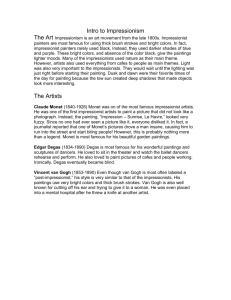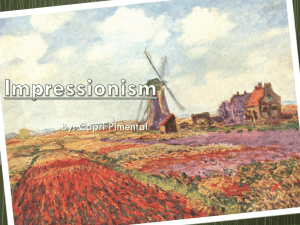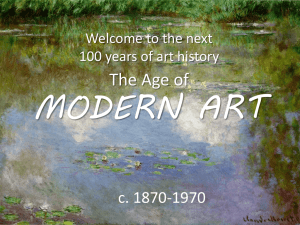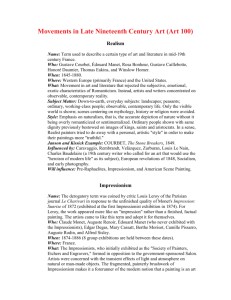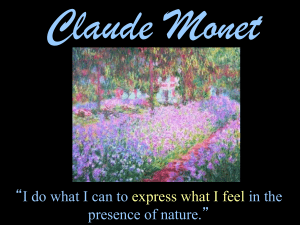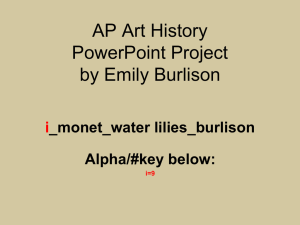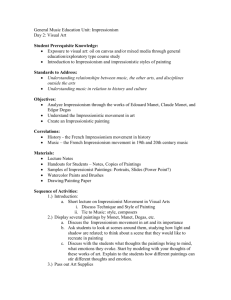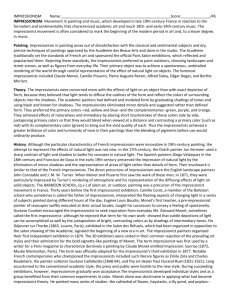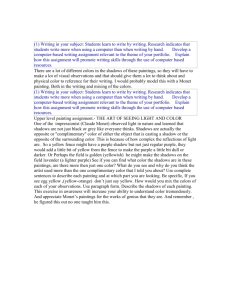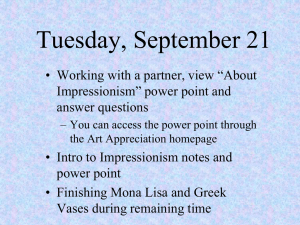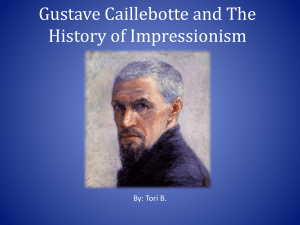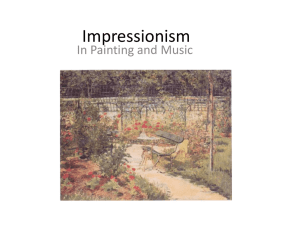Impressionism » Unit 5
advertisement
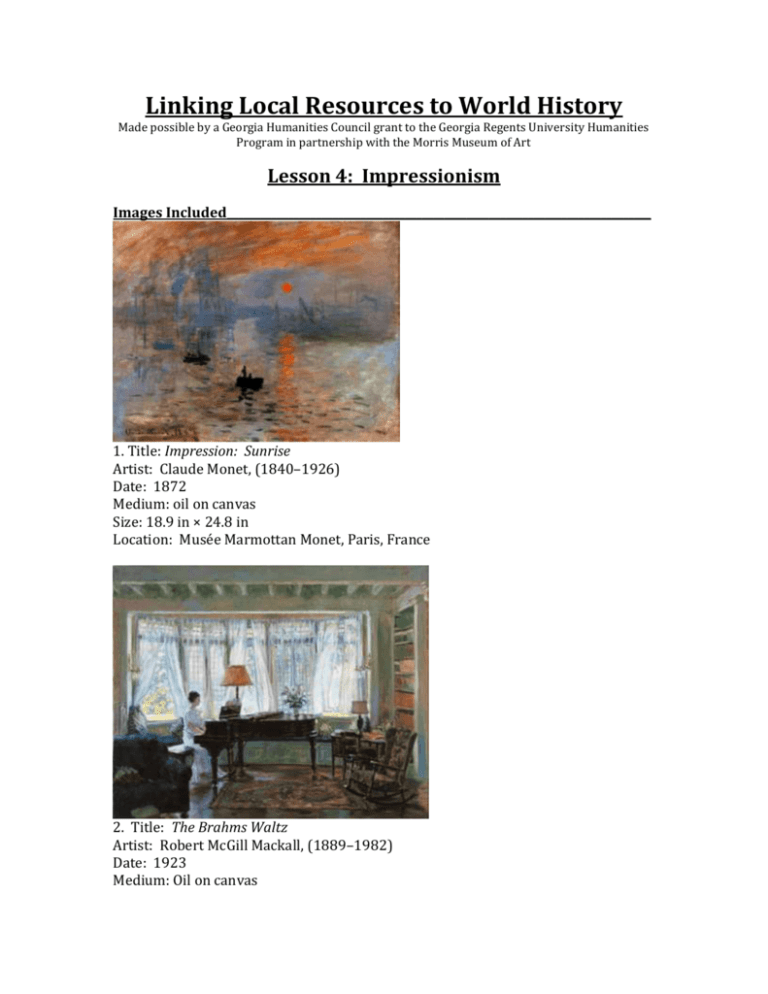
Linking Local Resources to World History Made possible by a Georgia Humanities Council grant to the Georgia Regents University Humanities Program in partnership with the Morris Museum of Art Lesson 4: Impressionism Images Included____________________________________________________________________________ 1. Title: Impression: Sunrise Artist: Claude Monet, (1840–1926) Date: 1872 Medium: oil on canvas Size: 18.9 in × 24.8 in Location: Musée Marmottan Monet, Paris, France 2. Title: The Brahms Waltz Artist: Robert McGill Mackall, (1889–1982) Date: 1923 Medium: Oil on canvas Size: 32 1/8 x 39½ inches Location: Morris Museum of Art, Augusta, Georgia 3. Title: Field of Poppies, Argenteuil Artist: Claude Monet (1840–1926) Date: 1873 Medium: Oil on canvas Size: 50 x 65 cm. Location: Musée d'Orsay, Paris, France 4. Title: A Long Time Ago Artist: Helen Turner (1858–1958) Date: 1918 Medium: Tempera on Canvas Size: Not Available Location: Private Collection 5. Title: Hydrangeas Artist: Jane Peterson (1876–1965) Date: 1912 Medium: Oil on canvas Size: 40 x 30 inches Location: Morris Museum of Art, Augusta, GA 6. Title: Savannah Harbor Artist: Eliot Candee Clark (1883–1980) Date: ca. 1924 Medium: Oil on canvas Size: 20.25 x 24.25 inches Location: Morris Museum of Art, Augusta, GA Historical Background_____________________________________________________________________ Impressionism was an avant-garde French modernist movement. An art critic gave the Impressionist movement its name when he used the term ‘impressioniste’ in his critical review of Claude Monet’s painting Impression: Sunrise, in what’s come to be known as the first Impressionist exhibition of 1874. Impressionist artists staged group shows for only about a dozen years, until 1886, yet many of their names are still household words: Monet, Pissarro, Renoir, Degas, Morisot, Cassatt. Impressionism’s effects began to reach America at the beginning of the 20th century and are with us still. When thousands or artworks were rejected by the official Paris Salon exhibition of 1863, Napoleon III sponsored a display of many works refused by its jurors. The show was known as the Salon des Refuses, and some of its works caused uproar and scandal, none more so than Edouard Manet’s famous Luncheon on the Grass. It depicted a naked woman picnicking with middle-class men in contemporary Parisian dress. In direct disregard for traditional depictions of nudes, the woman ‘s nudity was not tempered by any symbols suggesting she functioned in the painting as a goddess, muse, or allegory, as was typical in art’s history. Rather, she seemed absolutely contemporary, local, and she even directed her gaze directly at the viewer. She and the painting were perceived, therefore, as morally questionable and shockingly modern. Manet and his works were extremely influential on the artists who went on to constitute the Impressionist movement. As their work developed, Impressionism came to be typified by a soft, high-key color palette and loose, visible brushwork that appeared to be spontaneous (and to many, unfinished and shockingly abstract), working outdoors (en plein air) directly from nature (the innovation of paint packaged in tubes rather than bladders made paint portable), an interest in capturing fleeting effects of light and atmosphere, and modern subject matter showing scenes of contemporary life in and around Paris, which was rapidly modernizing under reconstruction projects by Baron von Hausmann and the effects of industrialization and new technologies such as the steam locomotive and electric lighting. Analysis: __French and American Impressionist Works______________________________ Claude Monet and his friends, who called themselves the Societe Anonyme, organized their first independent exhibition in 1874. The exhibition was not well received by the public, which, confused by the loose brushwork, regarded the paintings as lacking “finish.” Compared to traditional French Salon standards, these works seemed no more than a brazen display of sketches. · One art critic said of Impression: Sunrise, “Wallpaper in its embryonic state is more finished than this seascape. The critic called the show an “Exhibition of the Impressionists,” a condemning riff off of Monet’s painting title. Though France gave birth to Impressionism, its influence soon spread widely to societies such as Britain, Canada, Australia, Spain, and America. Several American artists began studying in France from the mid-1800s such as James McNeill Whistler and Mary Cassatt. Some exhibited alongside the French Impressionists until the group’s dissolution in 1886. These Americans were influential in bringing European techniques and ideas to an American audience. A ‘golden age’ of American Impressionism occurred at the end of the French movement: from 1890 to 1915, when the nouveaux riche patronized the American Impressionists. Many American Impressionist paintings depict landscapes, a genre valued by Monet and Pissarro, among others, in France. However, many American Impressionists were figure painters, and some specialized in paintings of figures indoors. A common subject was women who were reading or playing the piano. An excellent example can be found in The Morris Museum of Art’s The Brahms Waltz by Robert McGill Mackall. Another interesting example of Southern Impressionist domestic interiors is Helen Turner’s A Long Time Ago (not currently on view at the Morris Museum of Art). Her works do not recall the color palette characteristic of the first generation Impressionists, French or American, but rather a more subdued, darker palette. Impressionists in the Southern States did not form a school of Impressionist painting such as those that developed in New York, Boston, Cos Cob and New Hope, Connecticut; however, they did practice in that artistic style and incorporated their own themes relevant to the South in an informal movement that flourished around the first quarter of the 20th century, after it was well established in these other regions. By 1871 Monet was living in Argenteuil, France. Around his home he found sundappled landscapes he translated into paintings, such as his Field of Poppies, Argenteuil, of 1873. Set in the countryside, a female figure in a long dress, a hat and an umbrella strolls along in a field of poppies with a young child. Poppy fields are consistently found in the hills of France and became a focus, providing a compositional diagonal that leads the eye into the painting as well as visual punctuation of bright color. In the later American painting Hydrangeas, artist Jane Peterson creates an outdoor Impressionist landscape much like Monet’s. And because she did not create her work until 1912, it is quite possible Peterson looked to Monet as a reference for her floral landscape. As in Monet’s Field, a woman walks through a floral landscape with a parasol. Particular attention is paid to paint’s ability to indicate patterns of light and shadow on the umbrella, dress, and flowers. Yet Peterson includes local adaptations. Hydrangeas thrive in the South’s heat and strong sunlight, so the Southern viewer would have recognized the flowers as part of the local environment. Yet Peterson actually painted this work in Oyster Bay, New York, at the Louis Comfort Tiffany estate renowned for its variety of flowers. Along with landscapes, seascapes, too, became a subject of interest to Monet and other European artists. A work by Eliot Clark is a fine example of a Southern Impressionist painter looking to European counterparts for inspiration. Spending winters in Savannah in 1922 and 1923, the city had a great impact on Clark’s work. Though inspiration for his color pallet generally came from his father, the tonalist Walter Clark, Clark color usage bears some similarity to the blues and grays in Monet’s Impression: Sunrise. Even the brush strokes forming the distant boats in the harbors are similar. Clark creates more detail in his harbor (see the sides of the ornate balconies); however, his approach to creating people eliminates detail, much like Monet’s. Tour and Contact Information____________________________________________________________ Georgia Regents University Humanities Program: http://www.aug.edu/Humanities/index.php Morris Museum of Art http://www.themorris.org/education/tours.html Request a docent-led tour at the Morris Museum of Art: http://www.themorris.org/education/tours.html or, email: education@themorris.org Curriculum Connections for High School Students Lesson 2: Impressionism This unit best meets specific Visual Arts Standards for use in the High School classroom. See the standards listed below: VAHSVACU.1 Articulates ideas and universal themes from diverse cultures of the past and present. a. Identifies how the issues of time, place, and culture are reflected in selected art works. b. Discusses how understanding the original context of an artwork affects a viewer’s connection with and interpretation of the artwork. c. Recognizes art, art styles and artists and talks about them from a wide range of perspectives, including cultural context, formalist, expressionist, conceptual, functional, and technical. d. Discusses the importance of art in daily life (personal significance, social commentary, self-expression, spiritual expression, planning, recording history, for beauty’s sake, and marketing / advertising). e. Supports, with examples from history, the assertion that humanity has an innate need to create or make their world a more beautiful place. g. Discusses the role of art in at least two historical cultures; compares and contrasts to art today. h. Discusses the role of art and artifacts as a visual record of humankind’s history and a vehicle for gaining understanding of another culture. Impressionism: Interpretive Questions for Discussion Assign the students or read as a group the information listed above Use the following questions below to guide the discussion 1. How would you describe impressionism as a style? 2. Do you think it is possible for impressionism as a style to exist outside of the examples of work that were created by the artists that are credited were responsible for the impressionist movement? Why, or why not? 3. The Morris museum’s Impressionism gallery is one of the most popular galleries at the museum. How has public reception of impressionist work changed over the years? What might be the reasons for these changes in attitude? Extending the Lesson Plan Assign students a studio art project that relates to the reading and discussion above. Have students create their own pictures in an impressionistic style. Using a digital imaging program (like Adobe Photoshop) have students digitally manipulate photographs using filters, blurring tools, exaggerated brush strokes, and color skewing to achieve the desired effects.
